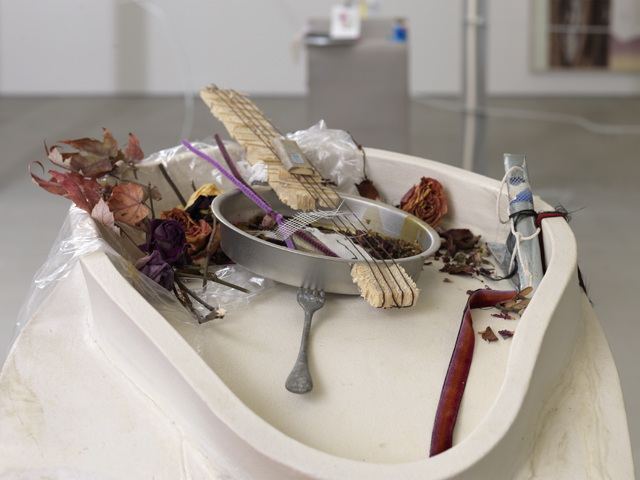How does an artist make something now that compels us to look longer than our modernised attention spans are accustomed to looking? The piling up, ease of access to, and relentless mutation of cultural information occasioned by the internet has so drastically altered the way we look and process images that it’s nearing impossible to remember a time when it was any different. Visual artists have been stumbling around this question and this new emergent mode of seeing for some time now. But efforts to create a compelling image that holds our gaze are still classically motivated. The density of the visual experience of a 15th c. Bosch painting for example or a 19th c. curiosity cabinet, are not that far removed from these two exhibitions I visited late February of this year in London.

Helen Marten’s tableaux of objects and forms are so lush and of such variety as to warrant comparison with some teeming, decadent old-world still life. Much in the same way Chardin might show us beauty with an exquisite and painting of a glass and a knotty pear on wooden table, Marten shows us such beauty in her accruals of ordinary things. An accrual that falls in step with a way of looking that comes natural to eyes accustomed to windows upon windows floating upon a sea of icons at a computer desktop.

Camille Henrot at Chisenhale gallery presents arrangements that evoke the curiosity cabinets and modes of presenting knowledge familiar to 19th c. natural history collections. I first encountered her work at the Venice Biennale last year where I saw her video piece Grosse Fatigue (2013). A kind of story of the universe’s creation; We look at windows popping up on the all too familiar landscape of a computer desktop, a perpetual unfolding of totems, retelling of myths, and all varieties of human bodies, and rummaging through treasures in at the Smithsonian in Washington, D.C. presented in the palm of a hand with perfectly painted and complimentary coloured fingernails. Style is a primary concern here. It’s fresh, but it brings to mind old nature documentaries from the eighties, the kind of thing we watched on flickering VHS tapes on monitors wheeled out on carts in science classes as children. But HD, a banging soundtrack and a breadth of scope elevate it and keep us from dwindling too long on what it might remind us of.

Her exhibition The Pale Fox at Chisenhale Gallery which opened last week, develops out of this work and addresses similar concerns with an installation. Explicitly: our desire to make sense of the world through the objects that surround us. Again, style is paramount here, Henrot’s über fashionable display systems taps the zeitgeist (big draped digital prints, kitschy found objects, window blinds, calligraphic cartoony drawings, expertly crafted wooden sculptures modelled after everyday signifiers – an Apple logo) while simultaneously reminding us of archaic methods of display in long established institutions of natural history.

In the same way it is difficult to imagine a a video from a description of it, it is difficult to get a sense of these exhibitions from photographs of them. One’s way of seeing in real life (IRL) is so different from the two dimensional abstraction of a photograph on a screen. Visually pilfering through a tableau as explosively diverse as this is not an option on a screen. The density manages to compel nonetheless.


